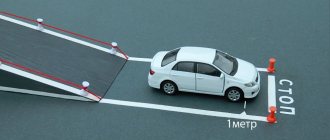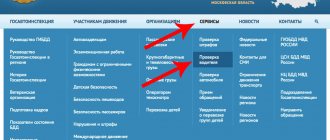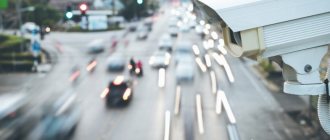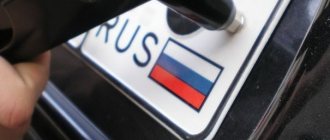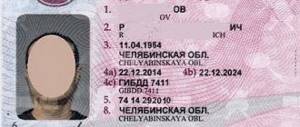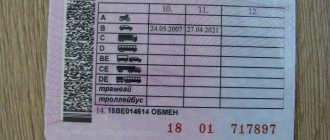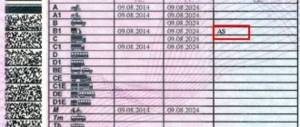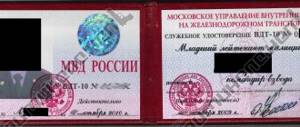Let's try to decipher the secret alphabet of driver's licenses. First, let's pay attention to the official marks on the license. They openly inform about what types of transport the holder of this license is allowed to drive. Let's take a closer look at the rights. It turns out that there are also other marks on them - unofficial ones. They are worth paying close attention to. Let's try to understand this secret writing.
Labels on licenses - what are they? Upon closer examination of some of the IDs, it turned out that they were marked with small and large holes, various embossed signs and dots. These badges most likely appeared during a meeting with inspection staff. This was done, of course, in secret from the driver. Such marks are placed on the license with a needle or pen.
The mystery of the marks on the license is revealed. Each area of the driver's license is intended for certain marks. The most popular place is photography. There are no instructions anywhere for unraveling the true meaning of each mark, so the same signs may have different interpretations. But let’s still get acquainted with the most popular tags.
What do the marks on the eyes say? If a mark is placed on one eye or both eyes, then it should be understood this way: the owner of the ID can easily be enraged. He is aggressive, swears, and can get into fights. Harmfulness - one eye, too much harm - both eyes.
The owner's greed is marked with a pen with two dots below the eyes.
If the area of the left eye is marked with a puncture, then you will get nothing from the owner except swearing, if the right eye, he will give money without swearing.
What does the nose “say”: the mark on the nose screams that the driver was detained while driving drunk, and a large sum of money was received.
The secrets of ear markings. Ears are marked in two cases:
- if the driver has good legal training, and the traffic police lost him one (puncture of one ear) or many (puncture of both ears) trials;
- if the driver is greedy.
What is “written on the forehead”. It turns out that the marks on the forehead have opposite meanings. They are put on the rights of a driver who gives a bribe, and on the rights of a very greedy owner. You can also read from the mark on the forehead that the driver did not respond to the inspector’s request to stop.
If the mouth is marked. A marked mouth is an angry driver who loves to swear.
About other marks Other marks mark various places on the driver's license. It is difficult to say about their true meaning, but it can easily be argued that if they are present, a meeting with an inspection employee does not bring anything good. Please note that there are many marks, but their meaning is the same - the owner did not please the inspector.
Who marks rights and why Marks on rights are a kind of mail for those who are privy to its secret writing. With its help, state traffic police officers transmit information about the driver to each other, which allows them to receive the largest amount of money.
Getting rid of marks Some amendments to the license are possible using available means, but the simplest and most logical way to get rid of marks on a license is to replace the driver’s license.
Save yourself Of course, today there are many unscrupulous inspectors who strive to “cut money” from the driver, but if everything is in order with your documents and the vehicle itself, there is nothing to be afraid of. To avoid the presence of marks on your license, strictly follow the traffic rules, remain calm when communicating with the inspector, be polite and patient. Keep your driver's license in a plastic pocket and present it to the inspector. In general, be careful!
What are the labels on a license?
The stamps on your driver's license may look different. These can be small depressed points from a sharp object, holes from a needle or awl, or points from a fountain pen. They usually appear after communicating with a traffic police inspector. Of course, such signs are not placed in front of the car owner. Most often this happens when inspectors are working together with you. One communicates with the driver, for example, checks the car, asks to show the contents of the trunk, go to a checkpoint or inspection booth, while transferring his license to the second.
How do marks appear on a driver's license?
It turns out that for many years there has been a “secret language” among traffic police officers that is unknown to ordinary people. Traffic cops put inconspicuous marks on driver's licenses. With these signs they warn their colleagues about the character and temperament of the driver's license holder.
Secret marks are small indentations, less often punctures, in certain places on a driver's license. Marks can be placed:
- ballpoint pen;
- awl;
- sewing needle or pin.
Marks are more likely to appear on your license when the inspection is carried out by two inspectors. One employee distracts the driver, and the second, under the guise of drawing up a protocol or checking documents, makes punctures in the driver’s license.
There is a “secret mail” among traffic police officers
What do they mean?
The meaning of the marks on a driver's license depends on where they are located on it. Most often, a photograph of the driver is used to transmit “secret data,” but marks can also be found in other places. Still, most often, traffic police officers put marks on the image of the owner.
Eyes
An inspector may leave marks on one or both eyes on the driver’s license in the following cases:
- Mark in the area of the left eye - a scandalous person, does not give bribes, swears. In the area of the right eye - the driver pays the money without further ado, calm.
- Two dots under the eyes tell the inspector that the person in front of him is greedy, you won’t get money from him
- The eye is marked - the driver is principled and “harmful”. Both eyes are marked - super harmful. It can mean “major” or “son”, who is hiding behind someone’s patronage.
- Marks on the eyes can be placed in cases where the driver is aggressive, he is easily thrown off balance, and in an acute situation it can even lead to a fight.
The specific meaning will emerge when talking with the inspector; remember, he is already prepared for one of these situations.
Ear marks are most often placed for the following reasons:
- The person is legally savvy, a lawyer. Won a lawsuit (piercing in one ear) or several lawsuits against the traffic police (piercing in both ears). In an ambiguous situation, it is better not to mess with this.
- The owner of the ID is greedy and you won’t get any money from him. In case of obvious violation, an official fine will have to be issued.
Marks with simultaneous indications of the eyes and ears mean that in front of the inspector is a “Judas” - a person who can record audio or video. Such marks on the license and their meaning tell the traffic police officer that he needs to be especially attentive and careful with him.
Markings on the nose are not interpreted so differently. In almost one hundred percent of cases, they mean that the car owner is a “military” person who was once caught drunk or committed some other serious violation and paid off with a large sum. He offers a bribe himself; there is no need to hint at a “peaceful solution to the problem.”
Marks on the forehead of an inspector can be given to a person who “bulls”, bargains with an employee, is greedy, but, nevertheless, strives to pay off in case of violations. With this, if you have persistence and free time, you can get a bribe.
Marks near the driver's mouth are not so common. The most common interpretation of a marked mouth is considered to be the driver's integrity or scandalousness and viciousness. Inspectors have to issue an official protocol to the “tagged” person - there will be no bribes.
A dot on the neck means that a person, as they say, “uses.” The inspector understands that the man in front of him is a drinker and has already been caught for this offense, but paid off. Unscrupulous inspectors can carry out a provocation, using various tricks to “bring” the driver under the article for drunk driving.
Find out about the car's VIN code in another article.
Breast
A dot on the chest means a person with a “heart.” This is usually a minor offender, communicates with inspectors cheerfully and peacefully, and jokes. This person can be fined, or he can be released. In any case, a conversation with such a driver is a little entertainment in routine work.
In the prevailing unspoken rules of “road peace officers,” there may be other marks on the license, and their meanings in the owner’s photo may vary in different regions. But one thing can be said for sure - like a pirate “black mark”, they do not promise anything good when meeting with the traffic police - they mean that during previous conversations with inspectors the person “distinguished himself” in some way, did not agree with them and tried to challenge his violation.
Types of labels and their meanings
Most often, marks appear on the photograph itself; the most popular version of a “black mark” is a puncture in the face or neck. There are also designations in the form of letters or symbols, and you can also see damage to the rights themselves: a scratch or a bent edge. The most popular types of notes:
- on the upper part of the face;
- in the eye area;
- punctures on the nose;
- markings on the ears;
- points on the neck;
- puncture on the eye and near the ear at the same time;
- the letter "K" above the photo.
Important! If damage appears immediately after the meeting with the inspector, you can safely complain to the head of the department. If you are lucky, you will be given a new license.
Upper face
Marks are placed on the forehead and eyes. If after a meeting with the inspector a dot appears right in the center of your forehead, it means that you were marked as a greedy person who is used to bargaining. The eyes can mark separately or both at once. Most often this means aggression and expressiveness. Such a driver may argue with a traffic police officer and offer a bribe (dot on the right) or, conversely, refuse to pay (dot on the left).
Ears and nose
If there are punctures on both ears, this usually indicates the driver’s legal awareness. Such drivers file complaints, go to court and cause traffic police officers a lot of trouble. A puncture on the nose indicates that the motorist was stopped while intoxicated. Sometimes in this way they mark out constant violators who want to pay off with a bribe. If the ear is marked at the same time as the eye, the driver is suspected of “espionage”: he is most likely recording conversations on video and a voice recorder.
Chin and neck
If the mark is in the corner of the mouth, the driver is most likely very confrontational and easily gets into arguments. Often this is not a simple objection, but an insult to an employee at his post. Marks on the neck mark those who like to drive while drunk, and a puncture in the chest indicates the easy character and sociability of the offender, who can be released if the offense is minor.
Important! You can protect your license from punctures and marks using a transparent silicone cover, which the inspector will need to remove first, but during a quick inspection this is usually not done.
Special marks can be a real problem for car enthusiasts. They guarantee bias and can even get someone who has been tagged in error into trouble. It is difficult to judge how correct this system of signs is: there is no official confirmation. All that remains is to advise drivers to follow the rules so that the inspectors have nothing to reproach you with.
Why do traffic police officers mark your license?
Tags on licenses, both new and old, convey information that is easily read by traffic police inspectors. With their help, they convey tips to each other, characterizing the driver from the side they need in order to obtain the greatest benefit. Tags save them time by immediately preparing inspectors for a situation that is beneficial to them.
You probably immediately decided to check your rights after reading the article. And some were able to discover “mysterious” signs there. So what's now?
How does she appear?
Traffic cops' marks on licenses are installed with a needle or even a pen. In the latter case, after setting the mark, the ink is erased and a small depression remains. Sometimes a vehicle owner may find separately underlined letters on his license, but most often the marks are presented as dots in certain places on the document.
In this way, traffic police officers transmit information about the driver to each other. This helps them anticipate what to expect from a vehicle owner. There are a lot of secret marks left on licenses.
The meaning of some of them is completely unclear. Moreover, even traffic police officers from different regions cannot explain individual designations. The likelihood of certain marks appearing is very high if inspectors work in pairs. One of them is inspecting the vehicle, and the second is marking the driver’s license at this time.
In order to put a mark on the license, the traffic police inspector does not always need a significant violation of the driver. He may simply ask you to hand over your driver's license to him for a routine check. You comply with the request, and he will “mark” your rights.
Traffic cops put the appropriate marks with a ballpoint pen or usually a needle. But why use a pen, the ink will be visible? Subsequently, the ink is erased, and a dent remains on the plastic surface. It also happens that one of the letters on the driver’s license is underlined. But as statistics show, most often marks are made with a needle in certain places.
How to get rid of tags
There are many ways to do this. The simplest and most reliable of them is replacing a driver’s license. Of course, knowing about the marks on your license and their meanings, you can try to make “amendments” yourself, and even identify yourself as a principled “lawyer.” But experience says that this should not be done. With such an adjustment, you may not only fail to remove old tags, but also accidentally add new ones, adding yourself to unexpected categories of violators.
How to restore numbers, read here.
How to protect your rights from tags
The best way to protect your rights is not to break the rules. However, there are situations when unscrupulous inspectors try to accuse you of violations that you did not commit. In these cases, it is necessary to behave with restraint and calm, not to shout or make trouble.
If you do not feel able to communicate peacefully with the traffic police, then try storing your driver’s license in a plastic case. And in it, give the rights to the inspector. Then it will be problematic to put a new mark, and it will be difficult to see the old ones under the plastic.
What do the marks on a driver's license mean?
Good afternoon, dear readers. Today I will talk about marks on driver's licenses. I note that labels can be either official (showing the category of the vehicle that the driver can drive) or unofficial. Unofficial marks on licenses will be discussed in this article.
All car drivers sooner or later have to deal with a traffic police inspector. Even a citizen who follows traffic rules runs the risk of getting his documents checked or something similar. In this case, the first thing that falls into the hands of a traffic inspector is a driver’s license, on which insidious marks may appear.
Our lawyers know the answer to your question
Free legal advice by phone: in Moscow and the Moscow region, in St. Petersburg, as well as throughout Russia
If we summarize all the above labels, we can draw the following conclusions:
- Marks are placed in the mouth area for conflicting drivers, for whom entering into an argument costs nothing. It does not always have a negative meaning, so you need to proceed from the situation;
- in the forehead area, designations are given to greedy and arrogant drivers who are ready to bargain even with the inspector. At the same time, they are not embarrassed by the potential opportunity to offer a bribe;
- Marks are applied in the eye area for various reasons. It is believed that the left eye indicates conflict and inadequacy of the driver, and the right, on the contrary, indicates calmness. At the same time, before our eyes, designations are made only for those drivers who can offer a bribe;
- nose and neck indicate an increased likelihood of driver intoxication. Previously, such a driver had already been stopped for similar offenses, but escaped punishment by illegal means;
- ears indicate the driver’s readiness to defend his rights to the end. It is better not to argue with this person, because at any opportunity he will go to court to punish the inspector.
ATTENTION !!! There are also letter designations, of which there can be a huge variety. For example, the underlined or displayed letter “K” shows the driver’s bad attitude towards the inspector and his aggressiveness. With such a designation you should not expect anything good from the inspector.
Any designations are not official and do not convey objective information. They are a way of transmitting extremely subjective information about the driver, but most often they contain negative information.
It is worth noting that stamps on a new type of driver’s license are not yet common, since such licenses came into circulation only recently.
What are license tags?
Marks on the license can be in various cases: small, barely noticeable holes, larger holes, various signs and dots embossed on the license.
Tags may appear after a meeting with traffic police officers. As you already guessed, no one will mark your driver’s license in front of you. This usually happens when inspectors work in pairs (one of them inspects your car, and the other marks your license) or when the inspector takes your license to his car, booth, post, etc.
To make a mark, use either a needle or a pen. When using a needle on the license, small holes (holes) are obtained. With a pen, they either make a mark on the license with ink, or without ink, i.e. by clicking on the right.
Why do they put tags?
Thus, one traffic cop gives some information about the driver to his colleague. A traffic cop stopped a driver, looks at his documents, sees a mark, now he knows how to behave with such a driver.
Surprisingly, not all traffic police officers use the same signs. For example, a unique mark on your license won’t tell traffic cops from another region anything. This only means that some marks may be quite “readable”, while others may not be at all.
Today, there are a huge number of such tags, and more and more appear every year. And the likelihood of marks appearing on your license increases if there are two traffic cops. One distracts the driver's attention to himself, he can ask questions or simply inspect the car.
At the same time, the second one quickly puts a mark on the ID. Naturally, this action is prohibited by law, and no one will mark it when the driver is closely monitoring everything that is happening. The marks are applied when the inspector takes your documents to a patrol car or to a traffic police post.
What do the labels on the license mean?
The meaning of the marks depends on which area of the driver's license they are located. Most often, tags are placed on the driver's photo, but other places can be chosen.
One can only guess about the true meaning of the marks. Therefore, the meanings of the same labels can be interpreted differently . Let's look at the most popular of them.
Marks on the eyes
The meaning of the mark placed on the eye (or 2 eyes) can be as follows:
1. The owner of the rights easily loses his temper, is aggressive, uses profanity, and things can lead to assault.
2. For harmfulness (2 eyes for super harmfulness).
3. Two dots under the eyes with a fountain pen - the owner of the rights is greedy and does not give money.
4. A puncture in the area of the left eye - he will swear and will not give money. A puncture in the area of the right eye - the driver is calm, he pays the money.
As a rule, a mark placed on the nose means the same thing in all cases:
The driver was caught driving while intoxicated (or caught doing something else) and paid off with a large sum of money.
Markings on the ears may appear in the following cases:
1. The owner of the certificate is legally savvy and has won one (one ear pierced) or several (both ears) lawsuits against the traffic police.
2. The owner is greedy.
But the meanings of the marks located on the forehead are interpreted with directly opposite meanings. They can appear both when the owner gives bribes and when the owner is very greedy. Another meaning of such a mark may be that the driver did not stop at the request of the inspector.
Markings around the mouth
Most often, a mouth marked on a driver's license means that the driver is angry and likes to argue.
There are also other marks that can be found in various places on the ID. Although their meaning is not known for certain, we can say for sure that they do not promise anything good when meeting with the next inspector.
I note that different types of marks can mean the same thing - the person has annoyed the inspector.
What do special signs from traffic cops mean?
Traffic police officers leave marks primarily for their colleagues, who will have to deal with the motorist in the future.
They characterize the person, the characteristics of his communication with the inspector, the ability to receive a bribe or the lack thereof, and legal literacy. Sometimes it’s just a minor dirty trick on the part of a road safety advocate to an intractable and scandalous driver or one who knows the laws well. To understand the labels on your license and their meanings, you need to look at exactly where they are located. In most cases, these are different places in the driver's photo.
The same designations in one region or another may be interpreted differently. A motorist whose license has a dent needs to evaluate the inspector’s style of communication with him. After all, it may depend on the information obtained using a point on the computer.
On the nose
A mark on the nose of the license means that the motorist was caught committing a serious offense, but chose to get by without a report using a bribe. And such a driver doesn’t even need to hint at a “peaceful” way to settle the matter, he will offer it himself. The dot on the nose may be on the rights of those who like to drive while drunk.
Before our eyes
Markings in the eye area can have opposite meanings, depending on the location:
- The dot on the left means that the driver is not afraid to enter into conflict with the inspector and defend his rights. It’s not worth waiting, much less demanding a bribe from him; it’s better to communicate purely officially.
- The dent on the right eye is evidence that the motorist will pay without making a sound just to get away faster. And then you won’t have to wait for him to complain to a higher-ranking employee.
- Two marks on the lower eyelids mean that the driver is, in principle, ready to give a bribe for the lack of protocol. But you can’t take much from him because of greed.
- Marks on both pupils are given to those who like to “pump up their license.” Sometimes this simply means a principled driver, in other cases it means that he has high patrons. You can expect trouble from such a person, even if he was stopped for business and they want to punish him according to the law. He is also capable of assault.
On the ears
Traffic police marks on your license in the ear area may mean that:
- The driver is well aware of his rights and has studied the laws. Therefore, you should not try to be disingenuous with him, much less extort a reward. Points are put on both ears for those who have successfully sued the traffic police, or have a legal education.
- The icon on one of them means that the motorist will not give a bribe, even if he violated traffic rules. And it is better to work with him, observing formalities, that is, with protocol.
Marks on the ears of various types are also given to those who can use a voice recorder or video record when communicating with the inspector. More often they are combined with punctures or points in the eye area.
On the forehead
The most offensive marks for a motorist are horns or the letter K. They mean that, in the inspector’s opinion, he is a “goat.” That is, it is better not to get involved with such a person, especially if there was no violation. After all, he considers himself right in any situation and therefore is capable of driving the most persistent policeman to a nervous breakdown.
A dot on the forehead can mean stubbornness, arrogance, attempts to put pressure on a traffic police officer. But if such a driver is caught committing a real offense, you can receive a bribe. After all, he is used to solving problems not according to the law, but according to “concepts.” But this may also mean that the driver is capable of starting a fight with a police officer or leaving the post without permission.
Tags can be located in different places of the computer
Developing vigilance: all about the rights of a traffic police inspector and his responsibilities
On the lips
Traffic police marks on the driver's license in the mouth area indicate the motorist's scandalousness and readiness for conflict, regardless of whether he is guilty or not. They are given to those who are willing to pay only an official fine, but not a bribe. And it is not easy to obtain, since the motorist will most likely take a long time to prove that he did not violate anything.
Neck
A sign in the throat area marks those who should be tested for alcohol. After all, this man has already been caught driving drunk. And there is a high probability that he will give a bribe, even if he is currently sober and has not committed any other violations. There is no need to stand on ceremony with this motorist, since he is ready to do anything to quickly complete the proceedings with the inspector.
Breast
The marks on the driver's license from the traffic police on the chest mean a non-conflict person, fairly disciplined, and good-natured towards the inspector. If he breaks the rules, it’s in small ways, and he doesn’t refuse to answer. The icon indicates that the driver can pay for the lack of protocol if hinted. But you shouldn’t “press” him over a trifle; it’s better to limit yourself to a warning. Because this motorist is just a good person.
About labels on rights, see this video:
How to avoid tags?
A good way to avoid tags is to follow traffic rules, as well as to treat traffic police officers politely.
Well, you can protect your ID directly by storing it in special plastic pockets. In this case, the certificate is presented to the inspector directly in this transparent case .
Surely after reading this article you decided to examine your own rights. Curious to know what marks you found there and under what conditions they were obtained? Write about it in the comments. Good luck on the roads!
We also recommend reading:
The point in the upper left part of the photo where there is no face, I am more than sure that it is accidental, since there is always some kind of rubbish in the purse.
Yes, marks do occur, but after serious battles with DePS. When you simply hint to them that they are wrong, then we separate like family - without protocols or bribes. First of all, there is no need to attack a traffic police officer, there is also an article on this and you can get into trouble if you come across an experienced and principled one. But don’t crawl in front of him, raking documents out of the glove compartment with shaking hands, but first evaluate his actions - how he introduced himself (clearly and clearly stated his position and surname), presented his police officer identification (presented it, and not just waved red crusts in front of his face. “... in in expanded form." and removed with your consent when you consider it necessary (when you remembered, recorded, made a photo-video recording.) After which you have the right to find out the reason for the stop. Going to orientation, special operation, etc. offer to check by calling to the duty station, reporting the crew number and the employee's badge. In this case, you can (and should) communicate with the glass slightly open so that your hand does not get through, but the interlocutor can be clearly heard, the door is closed and the engine is running. Next, as a rule, follows wishes for a “bon voyage”, and no marks on your license. But there is one “BUT”. When, twenty years later, you get caught by this cop under different circumstances (anything can happen), then don’t be offended - their memory is just a subject of study at a research institute .
Konstantin - respect! So them!
In fact, I once wrote in an explanation in the protocol: “inspector such and such extorted a bribe from me in the amount of 1000 rubles.” How his eyes widened when he read it)))
I have a pierced left eye, in November I’ll go to change my license (I got it 10 years ago) and I’ll mark it for myself again - all the traffic cops see the mark and leave. Usually, after seeing the label, the dialogue is as follows:
- Do you like to argue with the inspector?
-When I know I’m right, I argue!
Somehow, the mark even helps me. The main thing is not to be afraid of them, but to defend your point of view!
Today I was stopped and my license was clean. After communicating with the traffic police officers, a dot appeared with the pen pressed in the upper left corner. because he didn't give me any money. Penalty for driving without low headlights on.
Good afternoon Vladimir St. Petersburg. No eye marks were found on the driver's license. But when photographing V.U. there is the inscription Libraries and a dot under the left eye. (the inscription is visible in the photo, it was made with some kind of solution; it’s just not visible to the eye)
I was once stopped at a highway exit and asked to take a breath to check for alcohol (everyone there was stopped for this purpose) - the device showed 0.9 ppm. I was working outside the city at the time, getting to work without a car was problematic, and therefore on weekdays I didn’t even allow myself to drink a bottle of beer in the evening. The inspector began to explain about the deprivation of rights, referring to the readings of the device, I responded by repeating that “I don’t know anything, I didn’t drink” and offered to go to the local hospital to get tested (they stopped me just 3 kilometers from the place of work, there in a populated area had its own hospital). The inspector convinced me, stopped other drivers and let them breathe (they had 0), then immediately to me - I have 0.6-0.9, he called a colleague on the radio - he came with the same device, which also showed something, gave me a breathalyzer in my hands and I checked the drivers myself (!!), then myself. But I stubbornly insisted that “I don’t know anything, I didn’t drink.” In the end, the inspector said something like “yes, I see that you are not drunk, there are no signs, BUT SOMETHING NEEDS TO BE DONE WITH THE DEVICE INDICATIONS.” As a result, they called a third machine, which contained an old test (you blow a balloon through a tube), which did not change color. After that they let me go, saying that this was the first time they had seen such a reaction from the breathalyzer. This whole action took us about 40 minutes.
In the evening, I bought myself the same test (with a ball), put it in the glove compartment, and in all subsequent cases, when they offered to test for alcohol, I took it out of the glove compartment and said: “Give it to me.” First yours, then mine, and we’ll compare the results.” They didn’t check it even once. And after some time I noticed a dot on my right ear (made with a pen).
Since then I have looked askance at electronic breathalyzers.
On the reverse side of the right (right side) 2 parallel stripes were extruded from top to bottom, slightly at an angle. Another dot in the hair above the ear, what could it mean? just wondering
